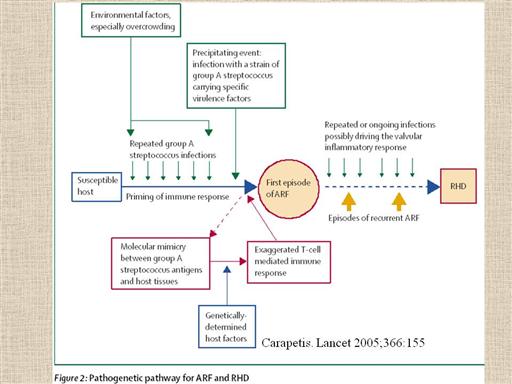| front |1 |2 |3 |4 |5 |6 |7 |8 |9 |10 |11 |12 |13 |14 |15 |16 |17 |18 |19 |20 |21 |22 |23 |24 |25 |26 |27 |28 |29 |30 |31 |32 |33 |34 |35 |36 |37 |38 |39 |40 |41 |42 |43 |44 |45 |46 |47 |48 |49 |50 |51 |52 |53| 54 |55| 56 |review |
 |
The pathogenic pathway for rheumatic heart disease starts with the susceptible individual. Twin studies have demonstrated that a genetic component may exist. Repeated streptococcal infections are thought to prime a susceptible individual resulting in a heightened response to an infection with rheumatogenic streptococcus. This results in acute rheumatic fever usually 3 weeks after the initial tonsilllopharyngeal infection. The precise pathogenetic mechanism has not yet been defined, yet strong evidence exists that an autoimmune response mediates the development of RF/RHD in a susceptible host. Genetically determined host factors interacting with the molecular similarity of the streptococcal antigens and host tissues results in the involvement of brain, joints, tissues and heart. The pathogenesis of RF/RHD is a complex maze of events involving major histocompatibility antigens, potential tissue-specific antigens, antibodies and superantigenic activation . However it remains clear that environmental factors such as overcrowding, poor living conditions and poor access to health care is the most significant determinant of disease distribution.
Lancet. 2005 Jul 9-15;366(9480):155-68. Acute rheumatic fever. |